I thought I would share this with the ASR Community since there might be folks out there with the same or similar issues
I have a pretty odd-shaped living room:

I have had various sound systems in it during the past 4 years and I have always had a huge issue with certain bass notes under certain circumstances.
For example when listening to tracks like this and this, the bass that should be coming from the left side I actually hear directly around my head, especially around my right ear....
It is a very annoying phenomenon that I have never heard in any other rooms; I guess it is due to that angled wall on the left-hand side reflecting bass sound waves in a funky fashion
(I am just speculating but could not come up with a better possible explanation)
During the years I have tried to solve it but could never come up with anything that would actually work - and since this is a living room I am very limited in terms of physical acoustic treatment
There was one thing that sort of worked but had downsides that shadowed the gains:
There is a VST plugin called GMonoBass that can 'monofy' the signal below a certain frequency that you can set. It did a great job, the ringing has stopped around my head but it introduced additional dips in the frequency range and it caused phase issues with movies (I have a 4.0 system and the whole 3D image of movies went out the window)
So I decided to no longer use it....
Then literally a few days ago I had an 'aha' moment while I was fiddling around with my CraveEQ plugin to boost the bass in my system
It can actually set any filter to behave in Mid/Side (M/S) mode instead of normal Stereo mode.
So what I tried is to set the boost filter (and only that) from Stereo to full Mid (with the system EQ-d to total flat in advance)

And wooow! The ringing around my ears is no more there, the impact is still there, I can still hear the bass from where it shall come from and the movies are not impacted either!
I am as happy as I can be - this simple thing just solved my issue I have been battling with for many years.....
If anybody has similar issues I would be curious to hear if this solution worked for you too
I have a pretty odd-shaped living room:
I have had various sound systems in it during the past 4 years and I have always had a huge issue with certain bass notes under certain circumstances.
For example when listening to tracks like this and this, the bass that should be coming from the left side I actually hear directly around my head, especially around my right ear....
It is a very annoying phenomenon that I have never heard in any other rooms; I guess it is due to that angled wall on the left-hand side reflecting bass sound waves in a funky fashion
(I am just speculating but could not come up with a better possible explanation)
During the years I have tried to solve it but could never come up with anything that would actually work - and since this is a living room I am very limited in terms of physical acoustic treatment
There was one thing that sort of worked but had downsides that shadowed the gains:
There is a VST plugin called GMonoBass that can 'monofy' the signal below a certain frequency that you can set. It did a great job, the ringing has stopped around my head but it introduced additional dips in the frequency range and it caused phase issues with movies (I have a 4.0 system and the whole 3D image of movies went out the window)
So I decided to no longer use it....
Then literally a few days ago I had an 'aha' moment while I was fiddling around with my CraveEQ plugin to boost the bass in my system
It can actually set any filter to behave in Mid/Side (M/S) mode instead of normal Stereo mode.
So what I tried is to set the boost filter (and only that) from Stereo to full Mid (with the system EQ-d to total flat in advance)
And wooow! The ringing around my ears is no more there, the impact is still there, I can still hear the bass from where it shall come from and the movies are not impacted either!
I am as happy as I can be - this simple thing just solved my issue I have been battling with for many years.....
If anybody has similar issues I would be curious to hear if this solution worked for you too

